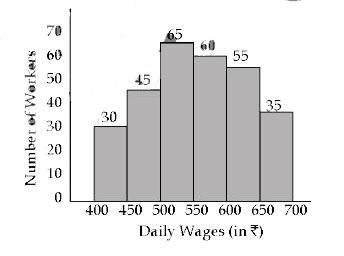Consider the following data:

What is the variability in the wages of the workers in Factory - A?
100% more than the variability in the wages of the workers in Factory - B
50% more than the variability in the wages of the workers in Factory - B
50% less than the variability in the wages of the workders in Factory - B
150% more than the variability in the wages of the workers in Factory - B
The correct Answer is:B
Coefficient of variation=S.DMean×100
For factory A=40.50540×100=7.5
For factory B=31620×100=5
∴Variability in wages of A is 50% more than the variability in wages of B.
Topper's Solved these Questions
- SETS, RELATIONS, FUNCTIONS AND NUMBER SYSTEM BOOK - NDA PREVIOUS YEARSCHAPTER - SETS, RELATIONS, FUNCTIONS AND NUMBER SYSTEM EXERCISE - MCQ
271 Videos
- TRIGONOMETRY - RATIO & IDENTITY , TRIGONOMETRIC EQUATIONSBOOK - NDA PREVIOUS YEARSCHAPTER - TRIGONOMETRY - RATIO & IDENTITY , TRIGONOMETRIC EQUATIONSEXERCISE - MCQ
238 Videos
Similar Questions
Consider the following distribution of daily wages of 50 workers of a factory.

Find the mean daily wages of the workers of factory by using an appropriate method.
View SolutionConsider the following distribution of daily wages of 50 workers of a factory.Find the mean daily wages of the workers of the factor}- by using an appropriate method.

View Solution
Knowledge Check
If there is a reduction in the number of workers in a factory in the ratio 15:11 and an increment in their wage in the ratio 22:25, then the ratio by which the total wage of the workers should be decreased is:
A6:5B5:6C3:7D3:5If there is a reduction in the number of workers in a factory in the ratio 15:11 and an increment in their wage in the ratio22:25, then the ratio by which the total wage of the workers should be decreased is:
A6:5B5:6C3:7D3:5Consider the following statements:
1. The Factories Act, 1881 was passed with a view to fix the wages of industrial workers and to allow the workers to form trade unions.
2. N.M. Lokhande was a pioneer in organizing the labour movement in British India.
Which of the above statements is/are correct?A1 onlyB2 onlyCBoth 1 and 2DNeither 1 nor 2
Consider the following distribution of daily wages of 50 workers of a factory. Daily wages: 100-120 120-140 140-160 160-180 180-200 (in Rs). Number of 12 14 8 6 10 workers: Find the mean daily wages of the workers of the factory by using an appropriate method.
View SolutionConsider the following information regarding the number of men and women workers in three factories I, II and III.
Men workers Women workers
I 30 25
II 25 31
III 27 26
Represent the above information in the form of a 3×2matrix. What does the entry in the third row and second column represent?
View SolutionConsider the following information regarding the number of men and women workers in three factories. I, II and III. Men workers Women workers I 30 25 II 25 31 III 27 26 Represent the above information in the form of 3×2 matrix. What does the entry in the third row and second column represent?
View SolutionFind the mean of the daily wages of 60 workers in a factory as per given below
View SolutionStudy the graph and answer the question that follows

What is the ratio of the total number of workers whose daily wages are less than Rs 500 to the total number of workers whose daily wages are Rs 600 and above?
View Solution
